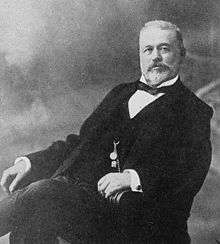Carlo Forlanini

Carlo Forlanini (11 June 1847 – 26 May 1918) was an Italian physician. He was the elder brother of aviation pioneer Enrico Forlanini.
Biography
Forlanini was born in Milan.
In 1870 he earned his medical degree from the University of Pavia, where he studied as an alumnus of Borromeo College.[1] Afterwards, he joined the staff of the Ospedale Maggiore in Milan, and later served as a professor at the universities of Turin (from 1884) and Pavia (from 1889), where in 1900 he was appointed chair of clinical medicine. He was notably a teacher of Scipione Riva-Rocci, the inventor of an early sphygmomanometer.[2]

Forlanini specialized in research of tuberculosis and respiratory disorders. In the 1880s he constructed an apparatus for inducing artificial pneumothorax ("collapsed lung") as a therapeutic treatment for pulmonary tuberculosis. His apparatus introduced nitrogen into the pleural cavity by way of a large hypodermic needle, and in doing so, produced pneumothorax. This work led to numerous nominations for the Nobel Prize in Physiology or Medicine from 1912 to 1919. [3] In 1906 Christian Saugman improved the device by adding a water manometer for measurement purposes.[2] This technique is no longer in use to treat tuberculosis.[4]
Today the "Carlo Forlanini Institute" in Rome, founded in 1934, is named in his honor.[2]
Selected works
- L'aeroterapia, Milano : Stab. Tip. Della Casa Edit. Dott. Francesco Vallardi, 1881 – Aerotherapy.
- La tecnica delle inalazioni medicamentose, Milano, Vallardi, 1883 – The technique of medicinal inhalation.
- Nuovi apparati pneumatici trasportabili, Milano : Dott. Leonardo Vallardi Edit., 1889 – A new transportable pneumatic apparatus.
- Storia di un caso di tisi polmonare curato colle iniezioni parenchimatose, Milano : L. Vallardi, 1889 – History of a case of pulmonary tuberculosis cured via parenchymatous injections.
- La cura della tisi polmonare col pneumotorace prodotto artificialmente, Pavia : Successori Marelli, 1907 – The cure of pulmonary tuberculosis using artificial pneumothorax.[5]
References
- ↑ Almo Collegio Borromeo (Pavia) - Study in Italy
- 1 2 3 Carlo Forlanini, inventor of artificial pneumothorax for treatment of pulmonary tuberculosis. Thorax. 1983 May; 38(5): 326–332.
- ↑ Hansson N, Polianski I. Therapeutic Pneumothorax and the Nobel Prize. Ann Thorac Surg 2015;100(2):761-5
- ↑ Apparatus for producing artificial pneumothorax, Birmingham, England, 1920-1940 Science Museum
- ↑ Most widely held works by Carlo Forlanini WorldCat Identities
External links
| Wikimedia Commons has media related to Carlo Forlanini. |